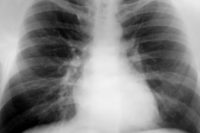New rule helps evaluate miners’ digital chest radiographs
From the Director’s Desk

 From the Director’s Desk
From the Director’s Desk
by John Howard, M.D., director of the National Institute for Occupational Safety and Health (NIOSH)
Since its creation, NIOSH has been responsible by law for administering a program that offers chest radiographs, or x-rays, to provide underground coal miners with medical monitoring for coal workers’ pneumoconiosis, or "black lung," the term by which this serious but preventable occupational lung disease is probably better known among the general public. The NIOSH Coal Workers’ Health Surveillance Program (CWHSP) evaluates miners’ chest radiographs for the presence and severity of changes in the lung associated with coal workers’ pneumoconiosis. The program uses a standardized classification system developed by the International Labour Office (ILO).
Until recently, the ILO system could only be applied to traditional film radiographs, because it required the use of film-based radiography, the only radiography technology that existed years ago when the technical standard was developed. As a result, the system (and critically for our agency, the NIOSH program based on the system) could not be applied to the modern, digital chest images, which have largely replaced film-based radiographs at medical facilities in the United States. Digital imaging has largely replaced film methods because of its many advantages: It eliminates the need to develop film. It allows the electronic images to be stored and used economically like other computer files. It allows images to be adjusted to improve visualization of abnormalities and to compensate for problems like over-exposure of the image.
Recognizing the need to modernize the CWHSP, NIOSH embarked on a sustained effort about seven years ago to enable use of digital chest imaging in the program. An important barrier was the need to develop the highly technical guidance needed to ensure that digital imaging would provide results equivalent to film radiography under the ILO classification system. This was important because the ability to adjust the appearance of digital images could potentially affect the interpretation of specialists who read the radiograph to identify and classify abnormalities associated with coal workers’ pneumoconiosis. Because a body of information in this area did not already exist, NIOSH and partners carried out the necessary research.
Based on findings from the research, NIOSH published a guidance document on best technical approaches to applying ILO classification to digital chest images (http://www.cdc.gov/niosh/docs/2011-198/). Then, using these technical specifications, NIOSH proposed federal regulations last January to enable use of digital chest imaging in the CWHSP. NIOSH then drafted final regulations that were responsive to public comments. On September 13, NIOSH achieved the major milestone of publishing the final regulations enabling use of modern, digital chest images in CWHSP (http://www.regulations.gov/#!documentDetail;D=CDC-2011-0013-0018). The new regulations will become effective on October 15.
Many have benefitted from these efforts. As NIOSH worked to update its own program, it partnered with ILO and helped to update the ILO classification system. Published in late 2011, this ILO update extends applicability of the classification system to digital chest images and makes digitized standard films available for use in film classification throughout the world. Those interested in classifying digital chest images using the ILO system may want to try out NIOSH BViewer© software. It can be downloaded for free from the NIOSH Digital Chest Radiography Web page (http://www.cdc.gov/niosh/topics/chestradiography/digital-images.html). The Web page also has information about the NIOSH image repository, a new effort to collect digital chest images that will be useful for teaching, quality assurance, and research in image classification for pneumoconiosis.
Those interested in the Coal Workers’ Health Surveillance Program, including healthcare facilities interested in becoming participants, can find detailed information on the Program’s Web site (http://www.cdc.gov/niosh/topics/surveillance/ords/CoalWorkersHealthSurvProgram.html).
The Coal Workers’ Health Surveillance Program is a key component of national efforts by diverse partners to prevent a terrible but preventable occupational lung disease. The repository of x-rays on file in our laboratory in Morgantown, W.Va., comprising more than 390,000 film images stored on more than 500 shelves, represents more than 40 years of continuing health surveillance and service. I am gratified by the hard work of NIOSH’s technical staff and their partners in updating the program to ensure it remains responsive to this continuing 21st century occupational health need.
Looking for a reprint of this article?
From high-res PDFs to custom plaques, order your copy today!







